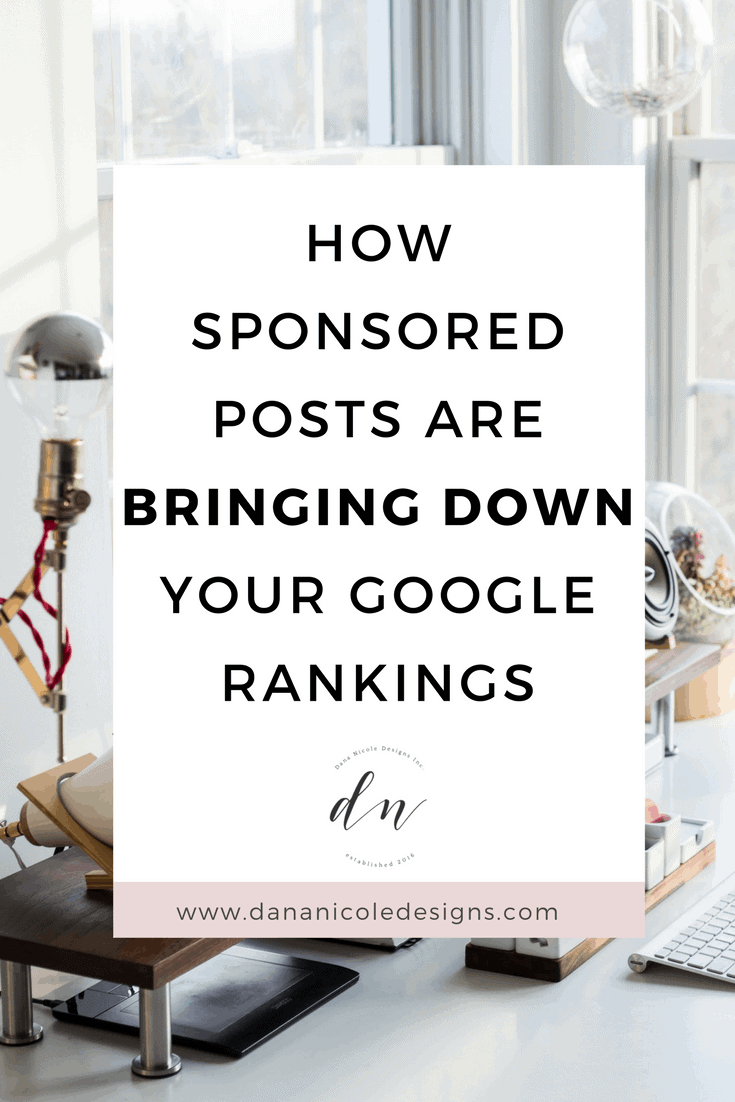Last Updated on
As a blogger or online business, one of your main sources of income is likely coming in through affiliate links and sponsored posts. And if your a blogger or online business, you also likely want to implement an SEO strategy so you get organic traffic to your site.

But did you know that affiliate links and links within sponsored posts can be hurting your SEO?
Why Google (Sometimes) Doesn’t Like Affiliate Links
If we know one thing about Google, it’s that Google loves a website that has lots of quality backlinks. We also know that it’s terrible practice to buy backlinks (if you aren’t aware, there are really spammy websites where you can buy a boatload of backlinks for your website. Do this and Google will penalize you).
So now, what’s Google’s beef against affiliate links and links within sponsored posts? Well, Google doesn’t necessarily penalize you for using affiliate links, but if you use them often it can comes across as spammy.
Google has outlined what they expect from you as an affiliate partner/marketer in order to keep your site SEO friendly.
In short, if you use an affiliate link that complements your content, and is 100% beneficial to your reader, than it’s A.O.K. according to Google.
However, let’s say you decide to compile a list of all your favorite resources and 90% of the links within those resources are affiliate links. Sure, you may think this is helpful, but Google thinks of this as spammy (I’m going to tell you a solution right after we talk about sponsored posts).
Why Google Doesn’t Like Sponsored Post Links
Another part of running a profitable blog is doing sponsored posts.
And unfortunately, sponsored links are another area of concern.
If you are being compensated (either monetarily or with free product) to write a blog post, this is seen as a link scheme in the eye’s of Google.
Like I mentioned above, buying links and participating in such will get your website penalized.
Let’s say that Company A reaches out to you and asks you to leave an honest review of their product on your blog, in exchange for a years supply of their product.
You agree to this, write your review and hit post. Then, Google and other search engines crawl your website and your newest post to see what it’s all about. When they are crawling, they notice you have linked to Company A, so they leave your site to go crawl Company A’s website just to see what’s up, and what’s so important with them that you decided to link to them.
When you link to another site, you are boosting up their SEO, giving them creditability and giving them some of your “link-juice”.
Usually, when companies reach out to you to get a blog post written up, it’s because they want to get their link in as many places as possible, with keyword rich anchor text, in order to boost their SEO.
However, doing this not only hurt their site, it hurts yours as well. But since your website is likely smaller than theirs, yours will feel the impact the most (ouch).
Why ‘No Follow’ and ‘Sponsored’ Is The Solution
In the above example, I mentioned how search engines will crawl your website, and when they see a link, they will pop on over to the website you have linked.
In terms of sponsored posts and affiliate links, you will want to turn them into “no-follow” links, which means that search engines will disregard them, and you won’t get penalized for writing reviews, participating in link-schemes, or having too many affiliate links on your site.
When discussing partnerships with companies, let it be known to them that you will not be including a “do follow” link in your post, but rather it will be “no follow” because you like to ensure you are following SEO best practices.
How To Turn Links Into ‘No Follow’
Turning your links into “no follow” is incredibly easy! If you are writing a by hand link it will normally look like something like this:
<a href=”https://www.dananicoledesigns.com”>My anchor text here</a>
You can also go into the “text” editor component under WordPress to view the code for your link.
Now, to change your link into a “no follow”, you just need to add: rel=”nofollow” such as:
<a href="https://www.thewebsite.com" rel="nofollow">My anchor text here</a>
You can use “nofollow” for affiliate links. For sponsored content, you just need to replace “nofollow” with “sponsored” and you’ll have code that looks like this:
<a href="https://www.thewebsite.com" rel="sponsored">My anchor text here</a>
That’s it! It’s an incredibly easy little trick to improve your SEO.
Did you use “no follow” links before reading this? Will you be using them going forward? Let me know in the comments below.
This article may include affiliate links. As an Amazon Associate I earn from qualifying purchases.

Dana Nicole is an award-winning freelance writer for MarTech/SaaS who was rated one of the best SaaS writers by Software World. She specializes in writing engaging content that ranks high in search engines and has been featured in publications like Semrush, ConvertKit, and Hotjar.
Dana holds a Bachelor’s degree in Business Administration and has over 15 years of experience working alongside national brands in their marketing departments.
When Dana’s not working, you can find her dancing en pointe, cooking up new recipes, and exploring the great outdoors with her two big dogs.

